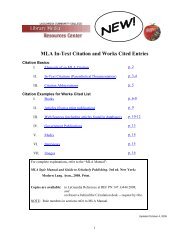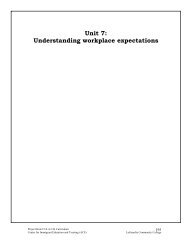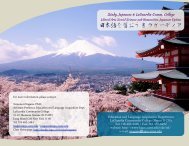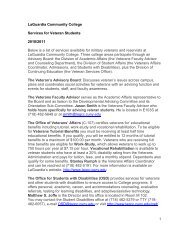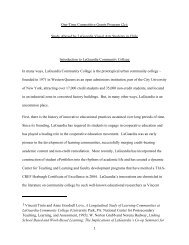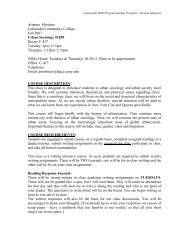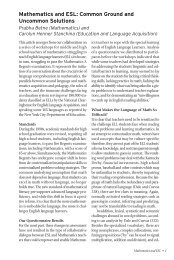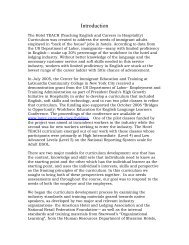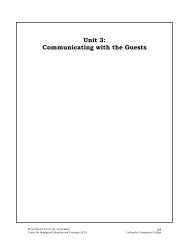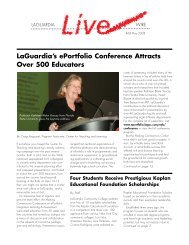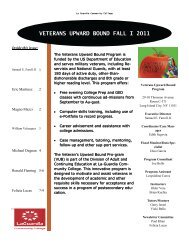Summer 2012 Newsletter - LaGuardia Community College - CUNY
Summer 2012 Newsletter - LaGuardia Community College - CUNY
Summer 2012 Newsletter - LaGuardia Community College - CUNY
You also want an ePaper? Increase the reach of your titles
YUMPU automatically turns print PDFs into web optimized ePapers that Google loves.
median income of $170, 486 in an online blog titled Census Pinpoints City’s Wealthiest, Poorest<br />
Neighborhoods by Arun Venugopal. Similarly, if one were to take the 1, 2 (to Wakefield, east 241<br />
St, where I live,) the D (to East 205 street), the 4 (Mosulu Parkway), or the 5 (to Dyre Ave),<br />
going uptown towards the Bronx he or she will find less glamorous and more poverty stricken<br />
areas, besides the traditional attractions of the Bronx Zoo and Yankees Stadium. According to<br />
an April 2010 report published by the New York City Department of Health and Mental Hygiene,<br />
the percent of residents living in poverty was highest in the borough of the Bronx. One<br />
can also take the 1 (to South Ferry), 2 (to Wall Street), 4 (to Bowling Green), and 5 (to Bowling<br />
Green), in the opposite direction to downtown Manhattan to wealthier areas such as Tribeca<br />
and Wall Street, a center of power, wealth, and financial activity. These subway routes allow a<br />
passenger to see and experience dramatic change and contrast in the standard of living of many<br />
New Yorkers and educate people about how there is a growing economic disparity in many<br />
neighborhoods in New York City.<br />
Beyond the economic disparities in the city’s neighborhoods one can also find change, contrast<br />
and diversity in the ethnicity of New Yorkers and its neighborhoods while traveling in and out<br />
the subway system. On any given day in New York City, an individual will normally see a diverse<br />
array of people from a variety of different ethic backgrounds stepping into a typical city subway<br />
train. For instance, the 7 train is well known for providing transportation to a diverse group of<br />
New Yorkers. It travels from Main Street in Flushing, Queens to 42 second Street-Times Square<br />
in Manhattan. While traveling on this train, one can observe change, contrast and diversity in the<br />
ethnic backgrounds of native New Yorkers., because the 7 train travels along Queens Neighborhoods<br />
that have been traditionally settled by immigrants from around the globe. According to<br />
New York Times reporter Bille Cohen, who documented different routes of the New York City<br />
public transportation system in January 2008, the 7 train line is “ known as the international express<br />
because it runs from Queens to Manhattan making stops in neighborhoods that are Chinese,<br />
Irish, Italian, Greek, Turkish Romanian, Indian and Mexican, just to name a few”. As a result,<br />
on any given stop along the 7 train, one can experience change and diversity in the ethnic<br />
backgrounds of Native New Yorkers and their neighborhoods in Queens. Riding a subway train<br />
such as the 7 line gives an individual a firsthand educational experience to the fact that Queens is<br />
the most diverse county in the United States.<br />
Another firsthand experience of change and diversity and contrast in the ethnicity of native New<br />
Yorkers and the look of their neighborhoods can be found on the 2 train line traveling from the<br />
North Bronx to Wall Street and the financial district in Manhattan along 7th ave. If an individual<br />
took the 2 line from the North Bronx at 241st street- Wakefield they would notice that most of<br />
the subway passengers are mostly from Hispanic and Caribbean backgrounds. The majority of<br />
the ethnic composition of the 2 train line would stay constant from 241 street-Wakefield in the<br />
North Bronx to125 street-Harlem in Manhattan; however, once the 2 train reaches 96th street,<br />
there is a dramatic population shift in the ethnicity of most subway passengers on the 2 line. At<br />
this stop, the 2 train cars become flooded with New Yorkers who are for the most part, Caucasian.<br />
Many neighborhoods on the Upper West Side of Manhattan and south of the famous black<br />
neighborhood of 125 th Street-Harlem are mostly populated by White New Yorkers. The dramatic<br />
population shift in the ethnicity at 96 th street is one of the biggest examples of change and<br />
contrast in New York City that can easily be witnessed by anyone riding the subways. Furthermore,<br />
riding the 2 train line provides a firsthand learning experience about the city’s native populations<br />
because the experience of the ride allows an individual to become more culturally aware<br />
of the fact that the Bronx is the only borough in New York City where its white citizens are not<br />
a majority of the population.<br />
The most striking and prominent examples of change, contrast and diversity in New York City<br />
can be seen throughout the city’s geographical and subway landscape. A dramatic example of<br />
change in scenery and landscape throughout the city’s subways can occur when a passenger stepping<br />
into a train beneath the city streets in Manhattan at one moment to eventually find himself<br />
or herself looking at the Brooklyn Bridge while standing in one of the several trains that travels<br />
on the Manhattan Bridge, which is adjacent to the Brooklyn Bridge. The ride over the Manhattan<br />
Bridge, which connects Manhattan to Brooklyn, could be represented by the N, Q, B or D<br />
train lines, since they all travel on the Bridge. Many New Yorkers often travel back and forth on<br />
the subways on a daily basis without ever realizing that most train stops are underneath the bor-<br />
16



